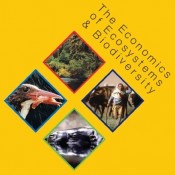TEEB: What’s the Buzz?
The Economics of Ecosystems and Biodiversity consortium (TEEB) has wrapped up commenting on its 200-page guide for bringing the goals of business into line with those of the environment. Now it’s time for a peek inside the massive piece of work that everyone is talking about.

The Economics of Ecosystems and Biodiversity consortium (TEEB) has wrapped up commenting on its 200-page guide for bringing the goals of business into line with those of the environment. Now it’s time for a peek inside the massive piece of work that everyone is talking about.
6 September 2010 | How do you get industry to pay for ecosystem services or mitigate the loss of biodiversity? Why would it be in the best interest of companies to pay for something they ostensibly receive for free? The Economics of Ecosystems and Biodiversity (TEEB) consortium provides some answers in its third report, TEEB for Business (also known as “D3”), a draft of which is posted for public comment on the TEEB web site.
The final report is due out next year.
The Series
The first report, Ecological and Economic Foundations, came out last September and laid the foundation for how biodiversity should be valued in terms of the ecosystem services provided. You may recall the headlines: the cost of global biodiversity loss was pegged at $3 trillion a year.
Having established this astounding value, the TEEB folks focused their next report on ideas for policy makers (TEEB for Policy Makers, and are now turning their lenses on the business community.
TEEB for Business makes the case for integrating the economics of biodiversity and ecosystems into the decision-making process of business. That’s a tall order, considering that this TEEB report is intended for all business sectors – from mining to information technology.
What’s Inside
TEEB for Business provides general ideas for identifying risks and opportunities related to biodiversity. Aggregate data backs up these ideas, and then TEEB provides specific case studies for inspiration.
It’s not, however, a how-to guide for every individual business. Indeed, the staggering range of business-ecosystem interactions will mean that individual companies or perhaps industry sectors will have to address, case by case, how to account for and manage their impact on (or opportunities from) biodiversity and ecosystem services.
Early on in the report, TEEB sets out to convince business that biodiversity loss is ultimately bad for business. It’s a difficult task, because TEEB acknowledges that businesses currently receive nature’s services for free and may currently face minimal regulatory compliance requirements. ‘Business: regulate thyself’ is not a message to be expected in this report, so the suggestions focus on voluntary efforts that should be pursued.
And why should a business voluntarily adopt biodiversity-friendly practices? TEEB makes the case that biodiversity is good for the bottom line.
The Value of a Good Name
The report makes a strong case for considering reputational costs, or the costs a business accrues due to a bad environmental reputation. For example, consumers could be dissuaded from purchasing products associated with poor biodiversity impacts.
Have you seen the fake ad Greenpeace created, showing someone munching on a Kit-Kat/orangutan finger? That ad heightened consumer awareness of the candy’s link to unsustainable palm oil production and destruction of orangutan habitat and left a bad taste for Nestle. Reputational costs can also come from government decisions on permitting, contracts or licenses.
TEEB for Business provides a tidy case study of a port operator that drained $45 million in sunk costs and was denied a permit for future work because of poor environmental reputation (see Ch. 2, p.27). The report also discusses operational costs, or those costs associated with disruptions to business due to scarcity of resources or disruptions to operations, as well as higher insurance costs for disasters such as flooding or storm damage.
Beyond the Obvious
The report also argues that businesses seemingly distant from negative environmental impact should consider accounting for, in a real monetary sense, the way biodiversity ecosystem services may affect their business.
Yes, it’s easy to see that a company employing big yellow bulldozers for vegetation-clearing has an impact on biodiversity. But what about an IT company? For companies like these where impacts to biodiversity may be indirect, it may be necessary to follow the supply-chain all the way down the rabbit-hole. Case-in-point: a fantastic diagram that Ricoh, an electronics and office equipment company, used to assess supply-chain and life-cycle impacts of reduced biodiversity to their operations (you’ll find it in Chapter 2, Page 25).
Nuts and Bolts Analysis
Businesses will likely find chapters three and four to be the most immediately-applicable to an analysis of biodiversity costs or opportunities related to their business. The chapters lay out the accounting and valuation methods for biodiversity ecosystem services risks of reduced or degraded biodiversity ecosystem services for businesses, as well as the tools that can be used to manage those risks, and strategies for ‘scaling down biodiversity and ecosystem risk.’
Every business is different. While the report tries to point to specific cases in which tools or strategies have been used, a company is not going to find specific guidance above and beyond general ideas or suggestions of accounting methods and risk management strategies. TEEB for Business is ultimately a rough, albeit comprehensive, guide to the current approaches being used, with excellent examples for inspiration.
Please see our Reprint Guidelines for details on republishing our articles.

